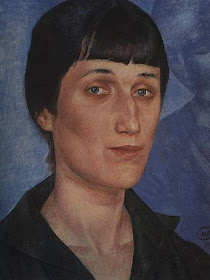 |
| Anna Akhmatova in 1922: portrait by Kuzma Petrov-Vodkin |
During the famine of 1920-1921, writer and teacher Alexander Neverov, made a harrowing journey from the Volga region to Tashkent to obtain food for his family. This journey became the inspiration of his novel City of Bread, which is considered a classic of early Soviet literature.
In the summer and autumn of 1941, as German armies advanced with alarming speed across the Soviet Union, the Soviet leadership embarked on a desperate attempt to safeguard its industrial and human resources.
Soviet authorities transported people and industry away from the western war fronts into the relative safety of their eastern lands. The Urals, Siberia, the Middle Volga, Uzbekistan, Tajikistan and Kazakhstan together received 16 million evacuees, with Tashkent a favoured destination. It remains the largest organised movement of a civilian population in history.
Rebecca Manley's book To The Tashkent Station brilliantly reconstructs the evacuation of Soviet civilians in one of the most dramatic episodes of World War II. Manley paints a vivid picture of this epic wartime saga: the chaos that erupted in towns large and small as German troops approached, the overcrowded trains that trundled eastward, and the desperate search for sustenance and shelter in Tashkent.
 |
| Cover of To The Tashkent Station |
I became a 3rd-year student at Tashkent Medical University. My sister passed the entrance exams to Tashkent Credit Economy College and was admitted to the Faculty of Industrial Economy. My mother went to work as a laborer at a tank plant. I had classes in the morning, and my sister started at 3 in the afternoon. We took turns looking after the child. In the evening our mother looked after the boy, and we could do our homework".
Among the evacuees were the intellectual and artistic elite: doctors, scientists, economists, playwrights, poets, actors, film directors, and composers were evacuated, often in their professional guilds, along with their supporting infrastructure. Moscow's State Jewish Theatre and its Theatre of Revolution relocated to Tashkent, as did the Leningrad Conservatory and Kiev's Polytechnic.
In 1943 the great Russian poet, Anna Akhmatova, finished the first draft of her masterpiece Poem Without a Hero in Tashkent at the Hostel for Moscow Writers at 7 Karl Marx Street. Alexei Tolstoi continued work on his play Ivan the Terrible there.
 |
| Faina Ranevskaya |
(As an aside: Igor Savitsky, founder of the Savitsky collection in Nukus, was evacuated along with the entire faculty and staff of Moscow’s Surikov Institute to Samarkand in 1942).
Of course there were many hardships: Uzbeks were forced to share their dwellings, prices in the bazaars rose and the influx of people put enormous strain on the city's resources. There were inevitable tensions. Some evacuees were homeless. Over 30,000 children were evacuated to Tashkent without their parents, many of whom were or became orphaned. Famously, an Uzbek blacksmith, Shaahmed Shamakhmudov adopted 15 orphaned children from the USSR's western republics. Many other Uzbeks adopted children during those years.
 |
| Shaahmed Shamakhmudov and some of his 15 adopted children |
Post-war, the tradition continued as Tashkent accepted over 11,000 political refugees following the Greek Civil War of 1946 - 1949.
In March 1953 after the expiry of Alexander Solzhenitsyn's sentence, he was sent to internal exile for life at Kok-Terek in the northeastern region of Kazakhstan. His undiagnosed cancer spread until, by the end of the year, he was close to death. However, in 1954, he was permitted to be treated in a hospital in Tashkent, where his tumour went into remission. His experiences there became the basis of his novel Cancer Ward and also found an echo in the short story The Right Hand.
 |
| Based on his time in a Tashkent hospital |
As visitors to the city today, you will also be struck by the warmth and respect that ordinary Tashkent people demonstrate. They are heirs to a grand tradition.
Related posts: The Greek Community of Uzbekistan
Tashkent's Soviet Buildings
48 Hours in Tashkent
Tashkent - A Stroll Along Anhor Canal
Materials source: Centropa.org for Sophia Abidor's story

